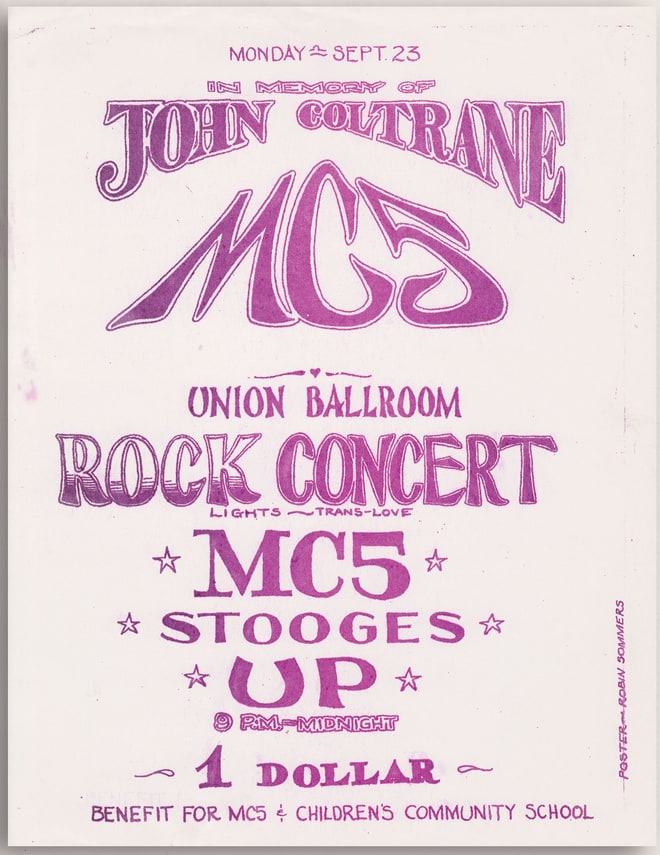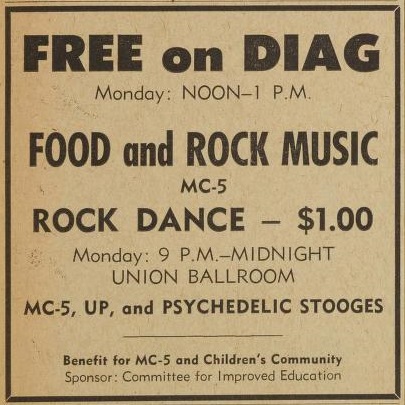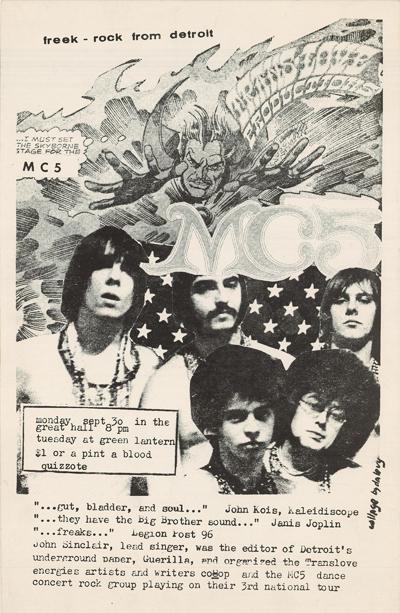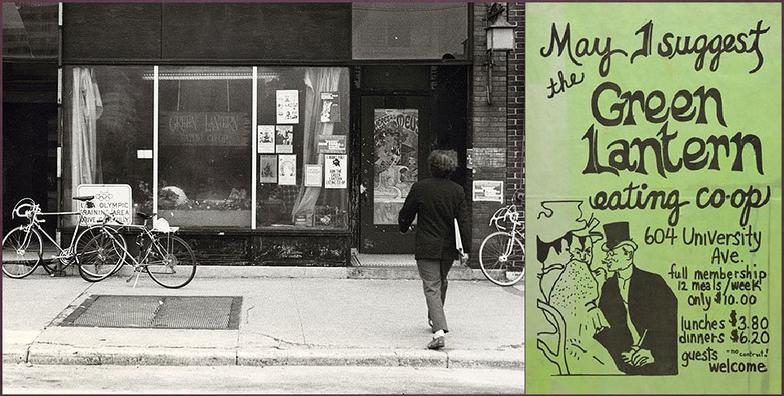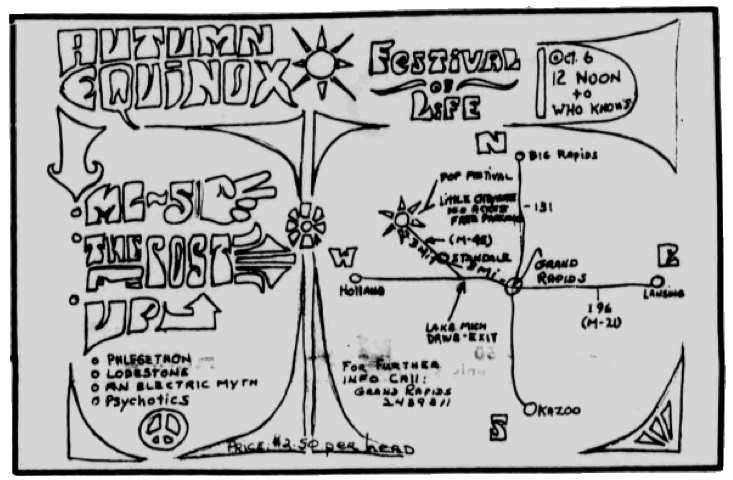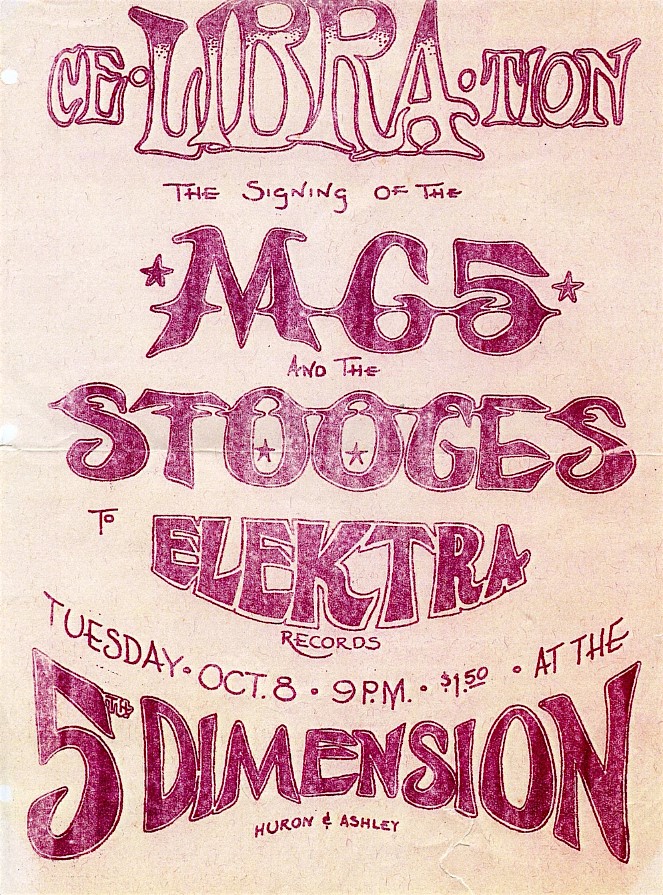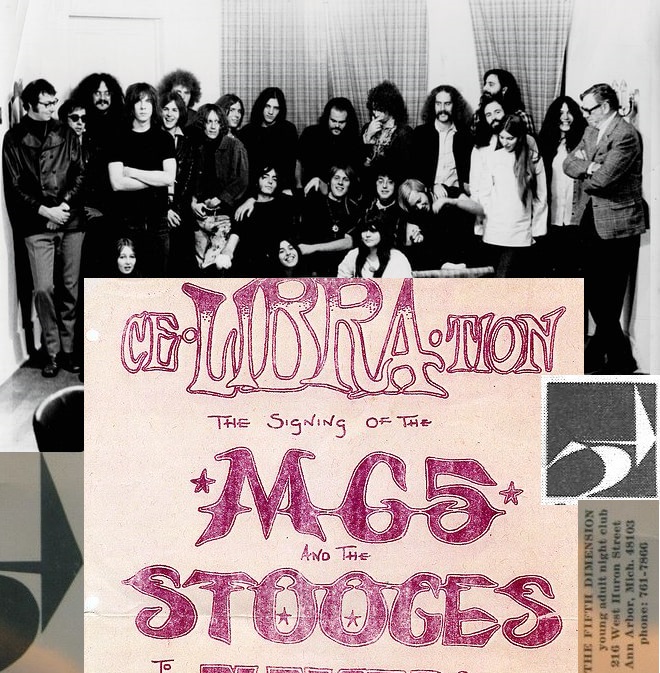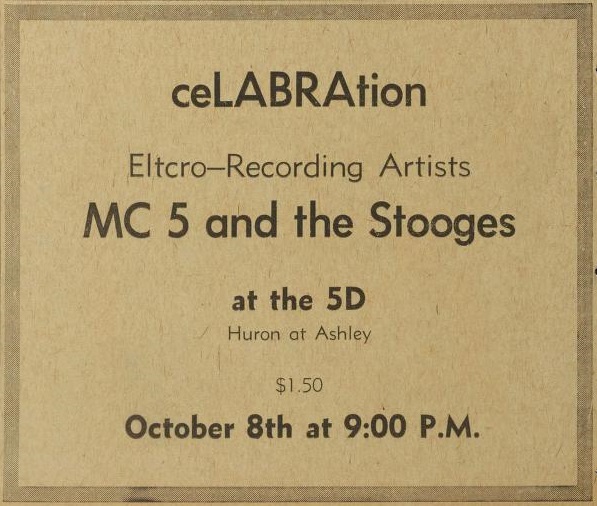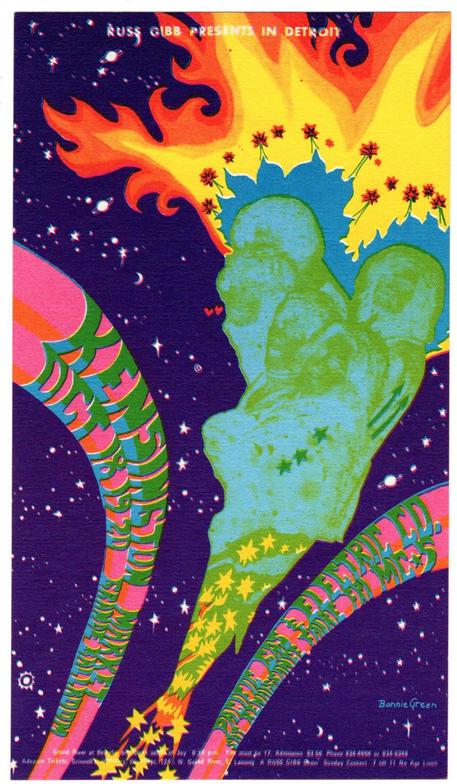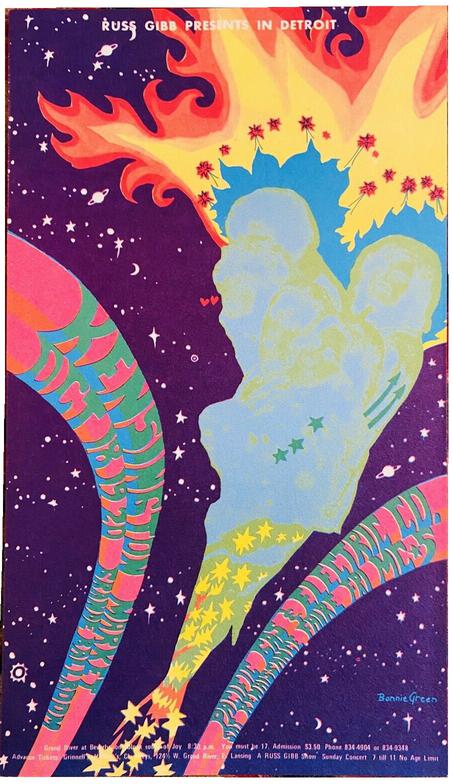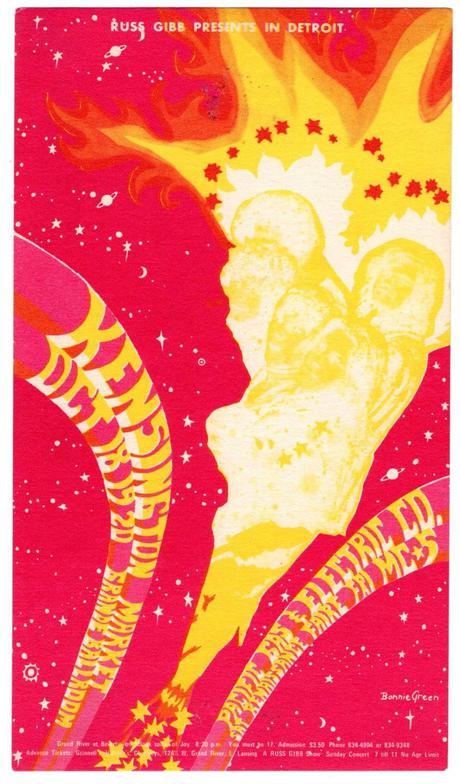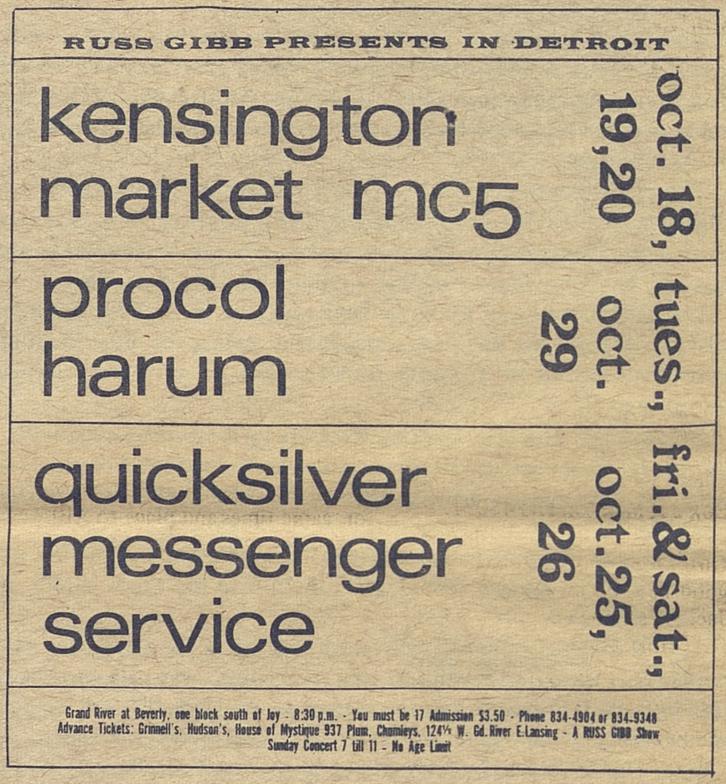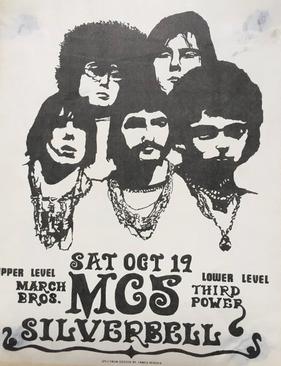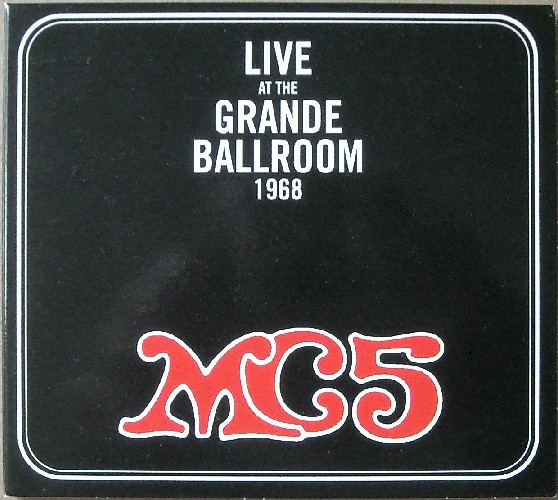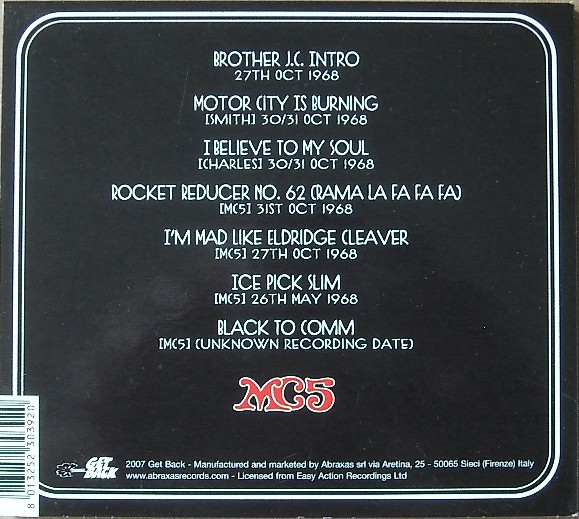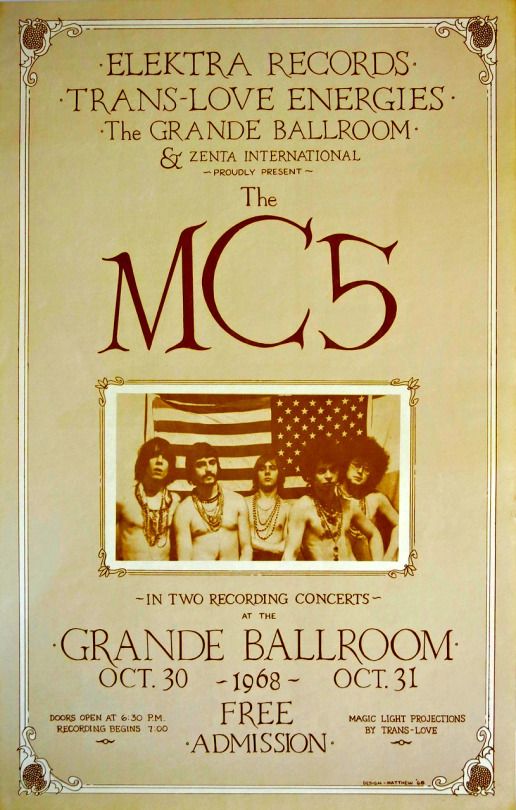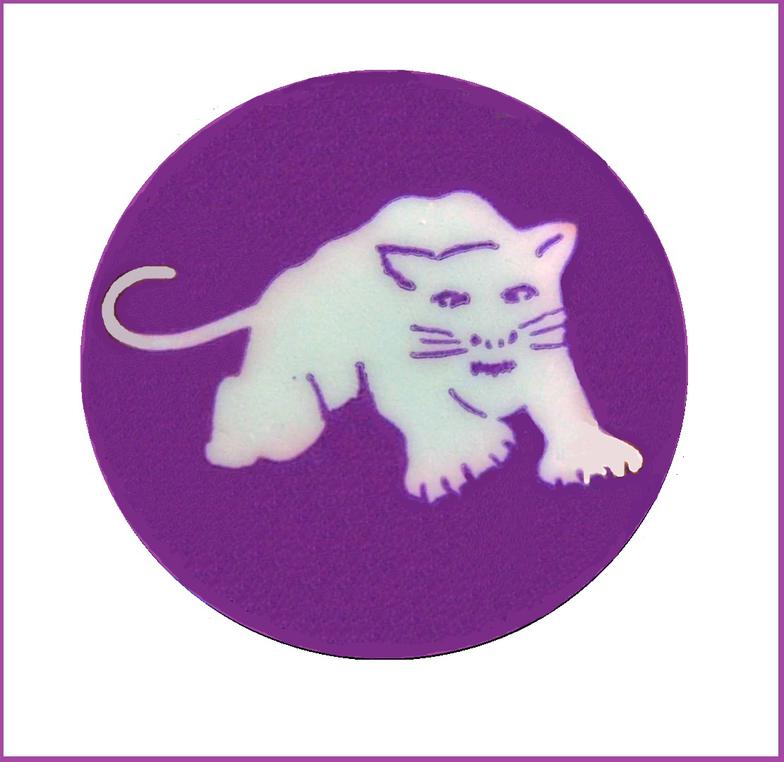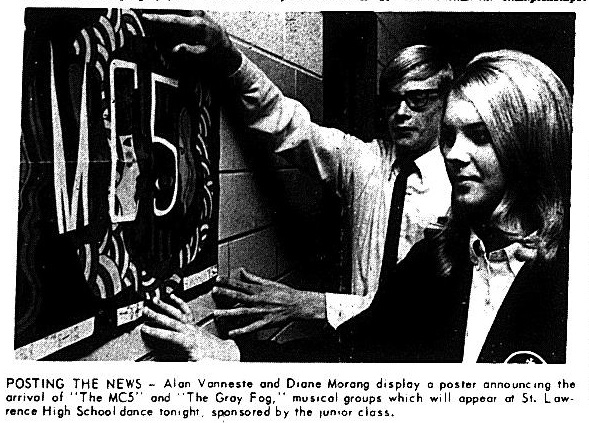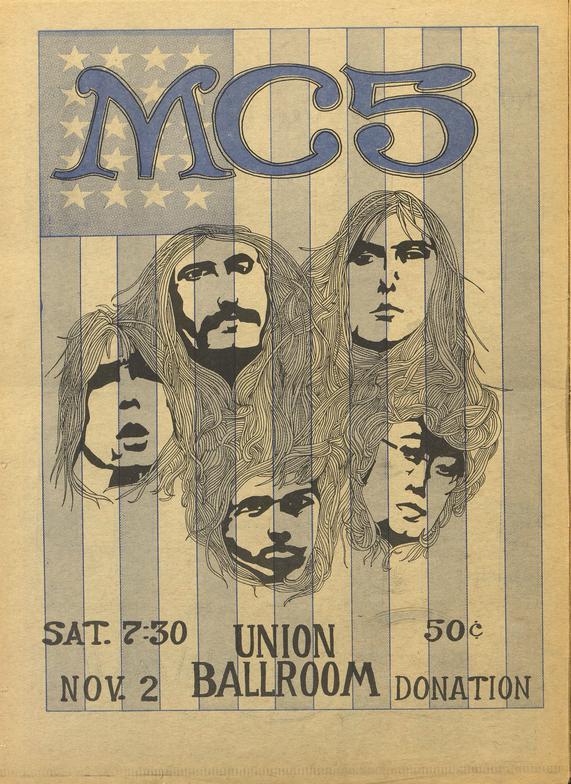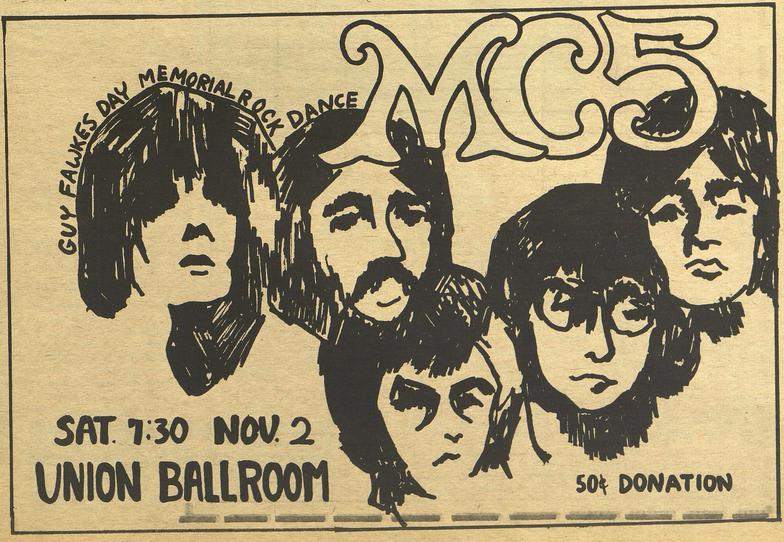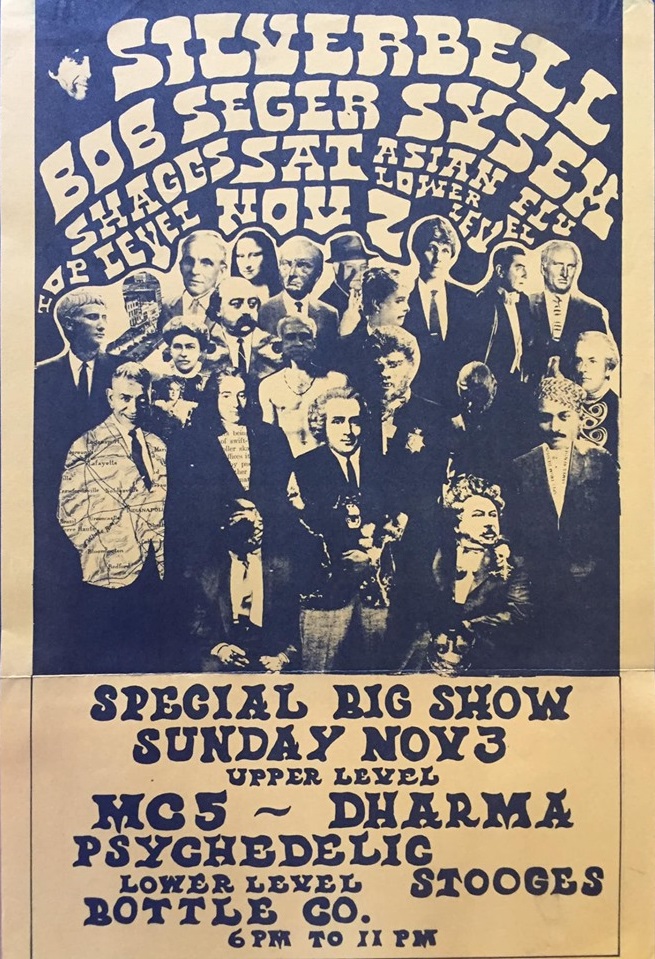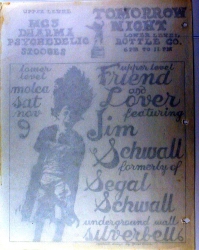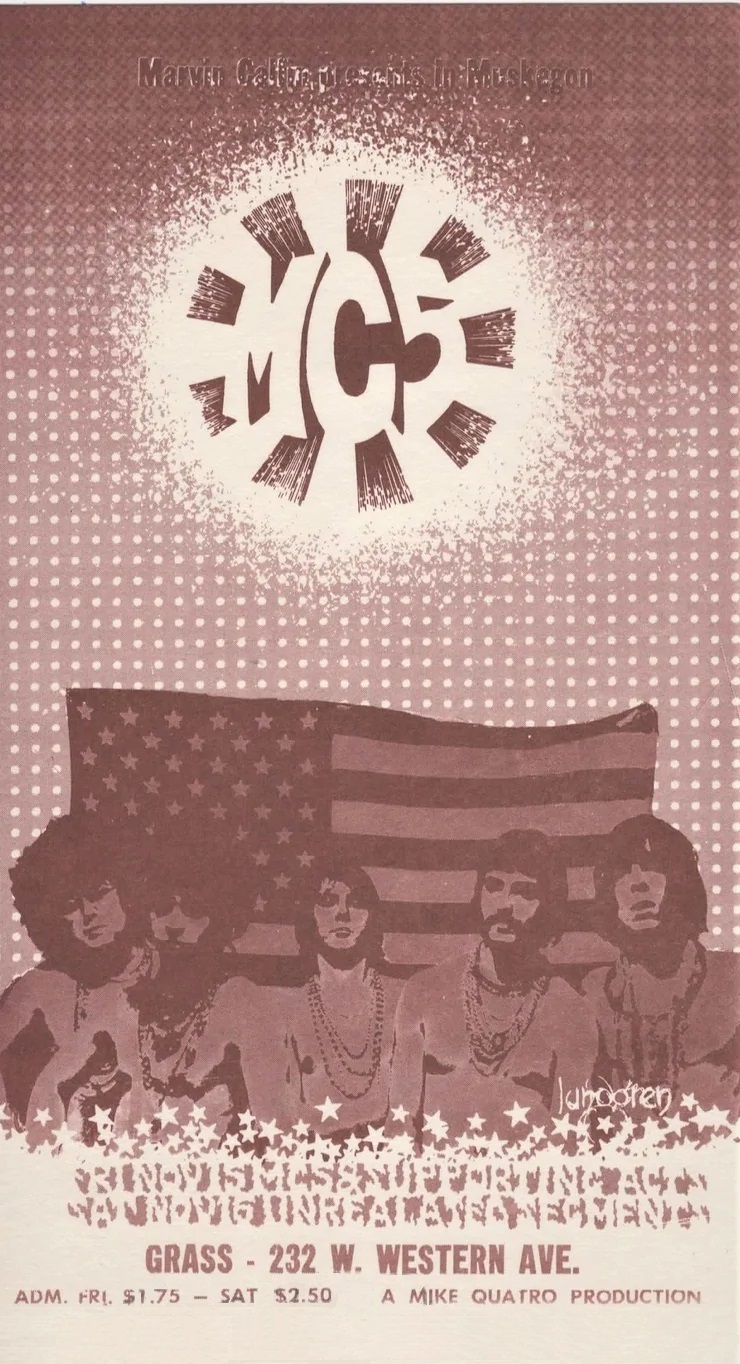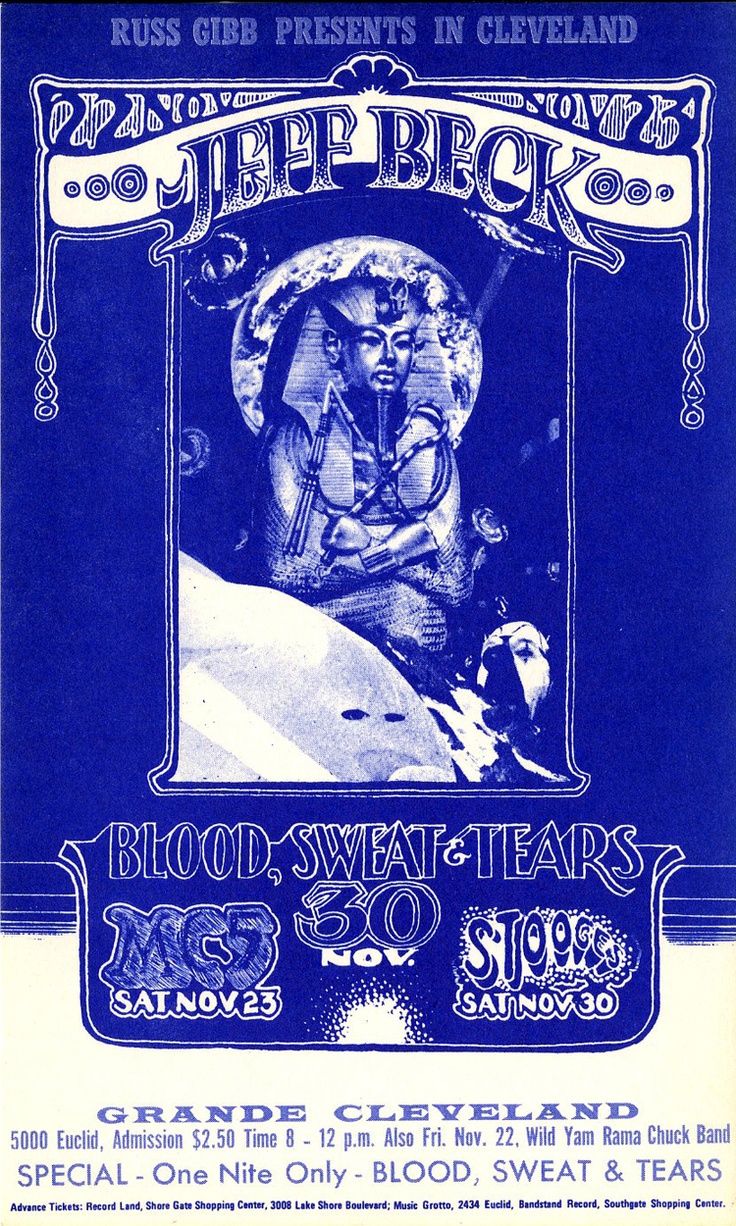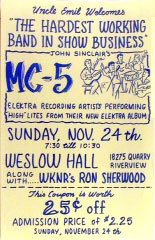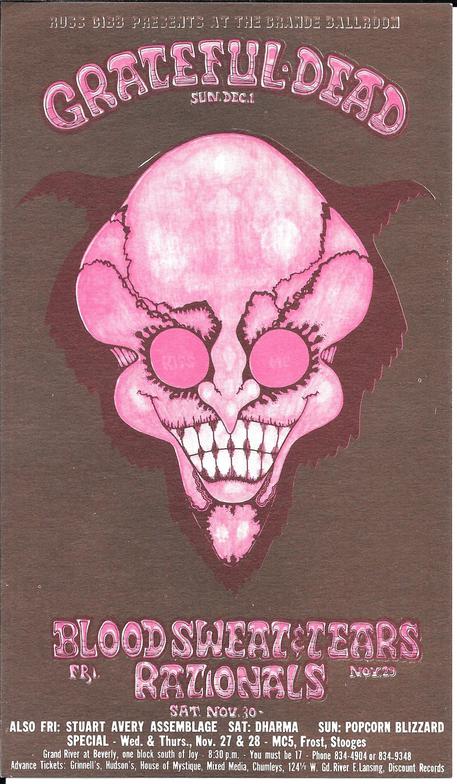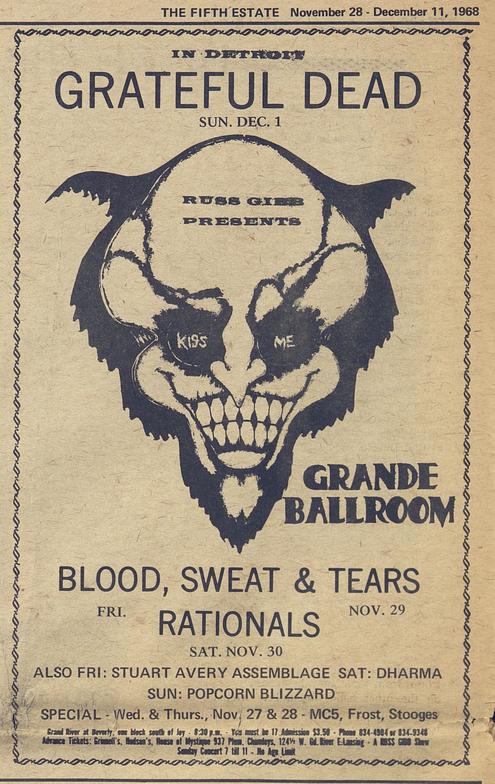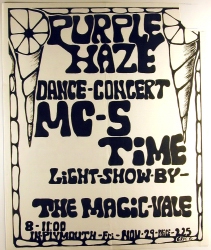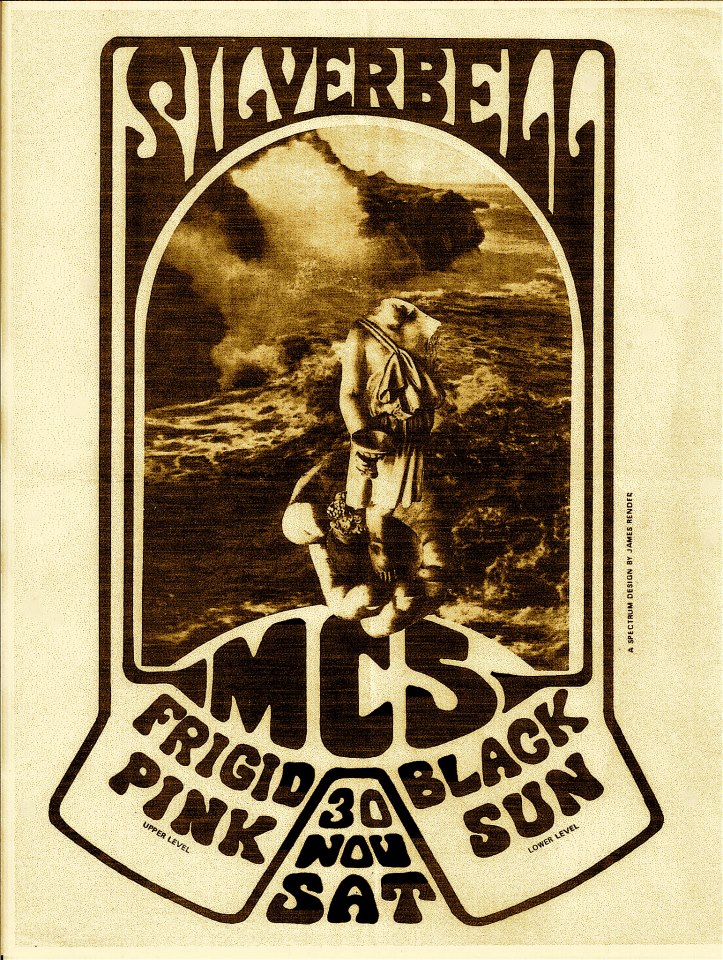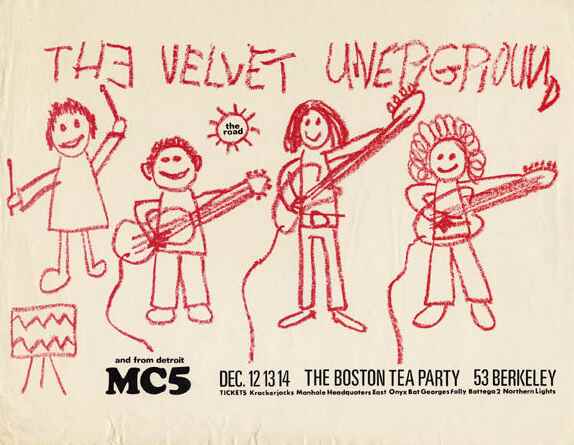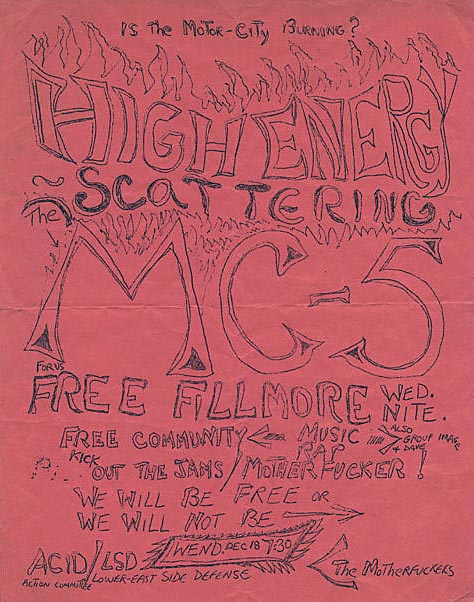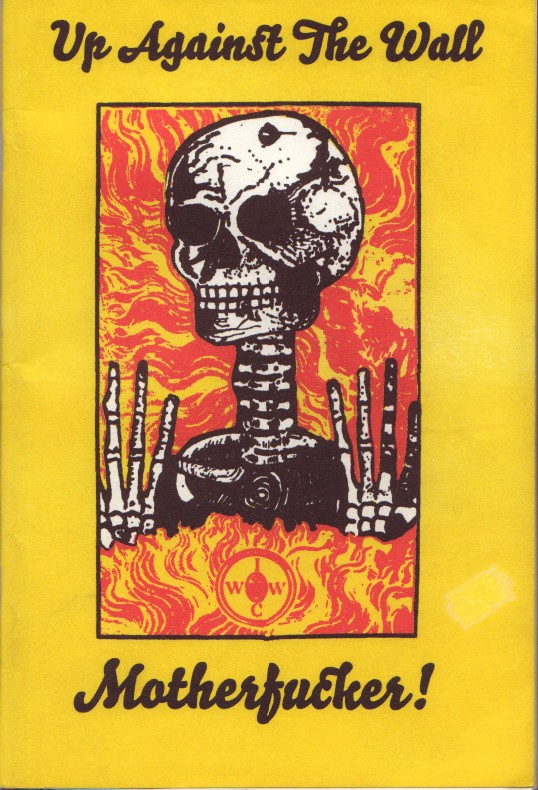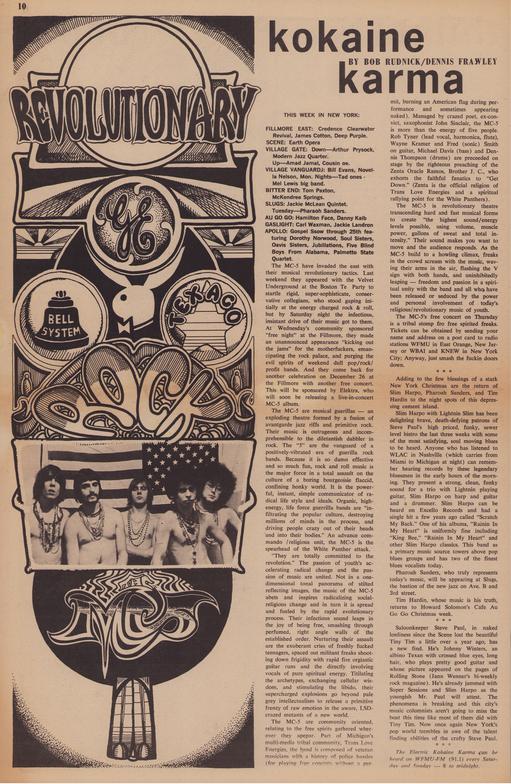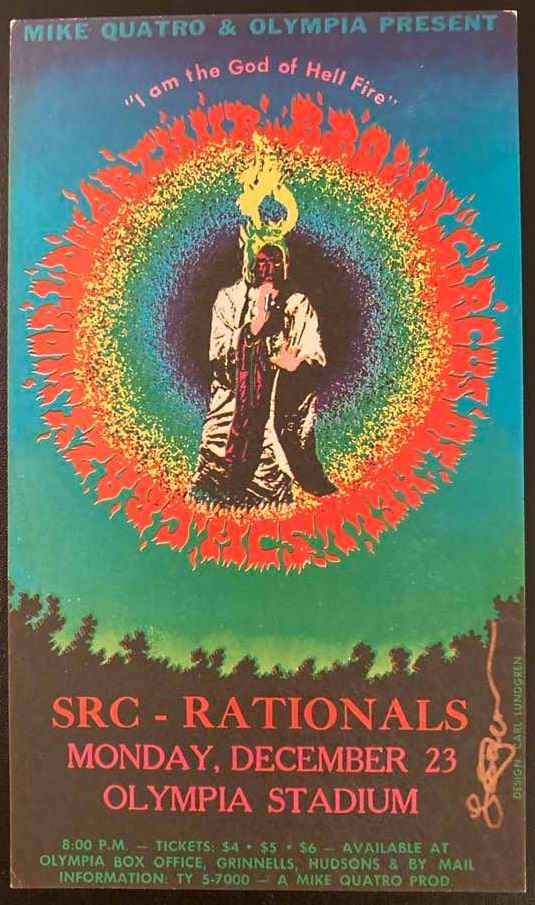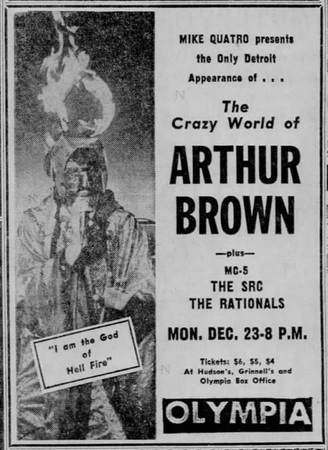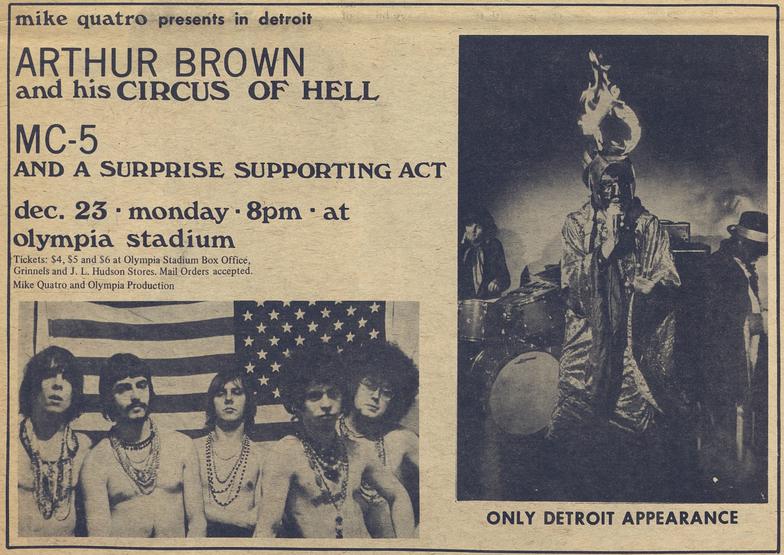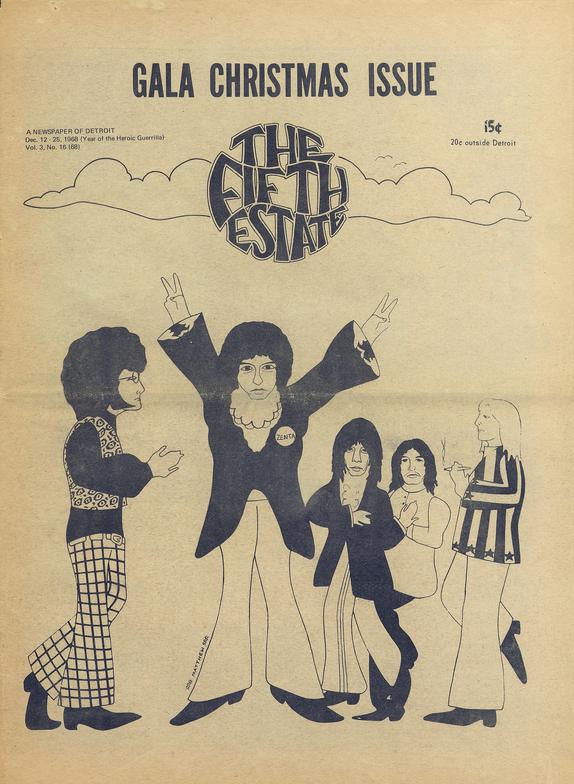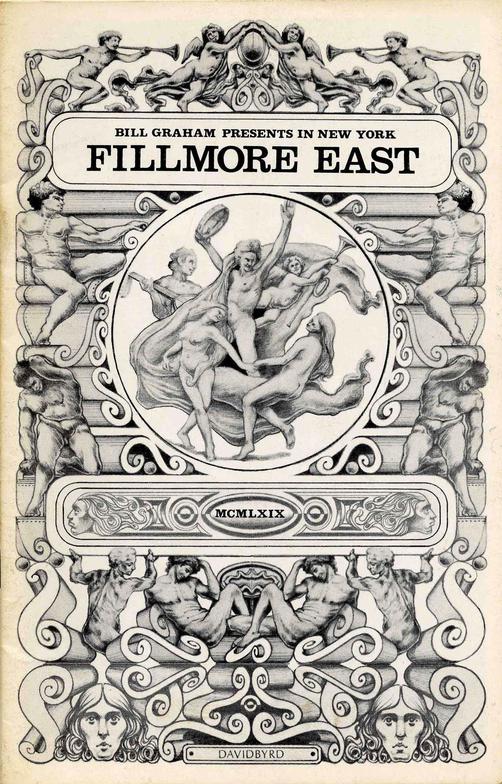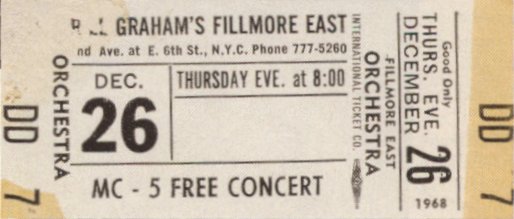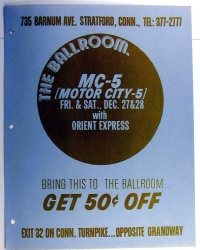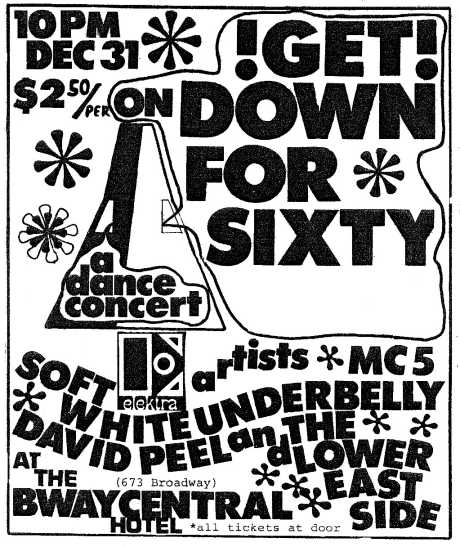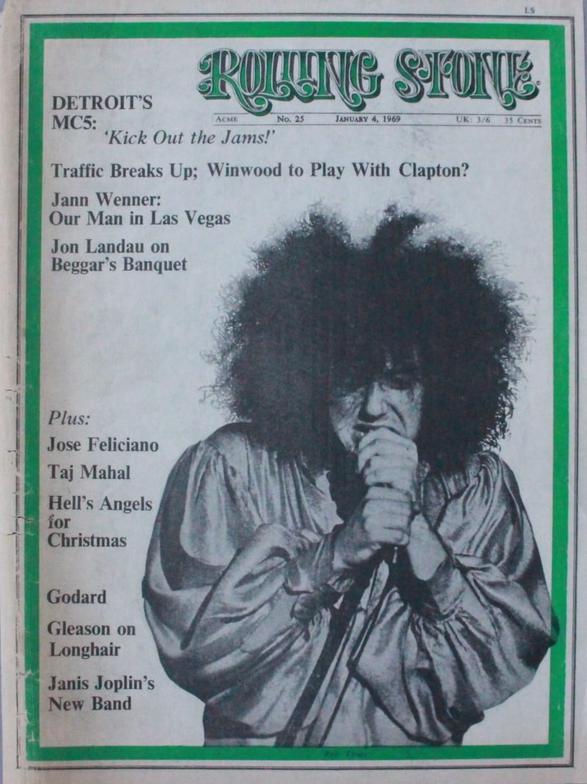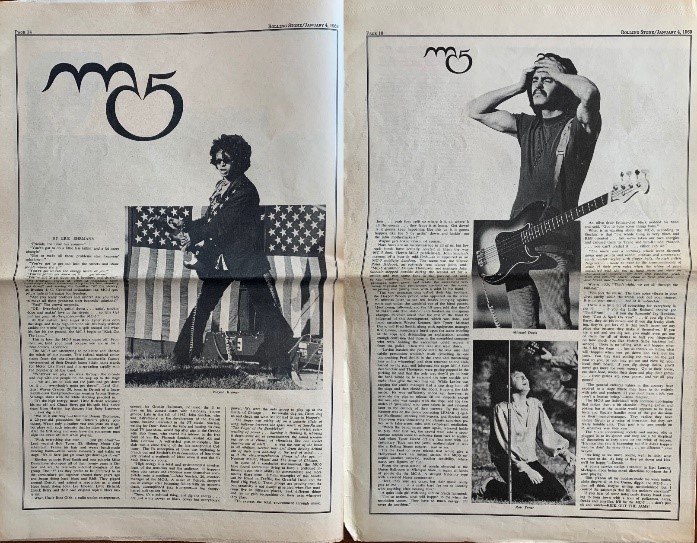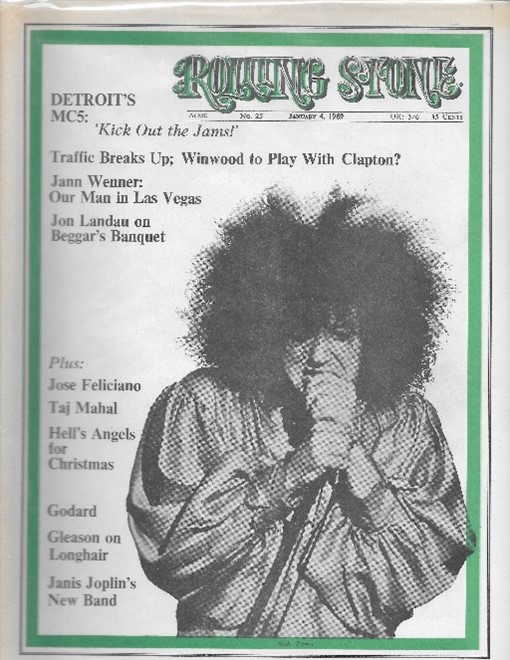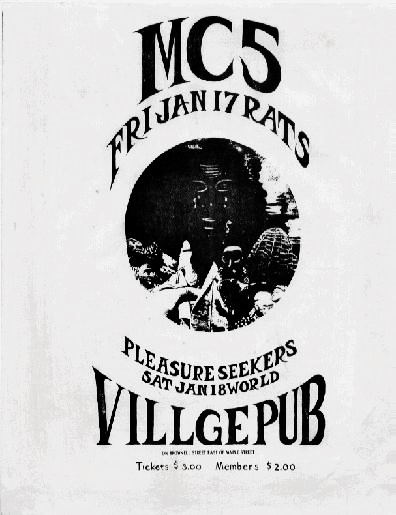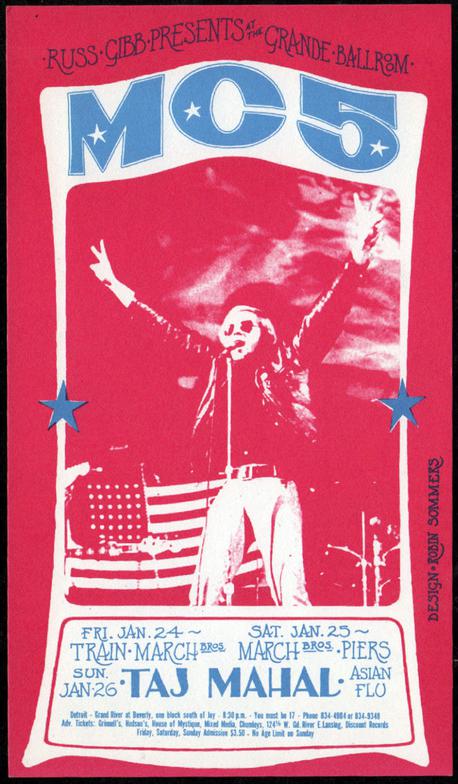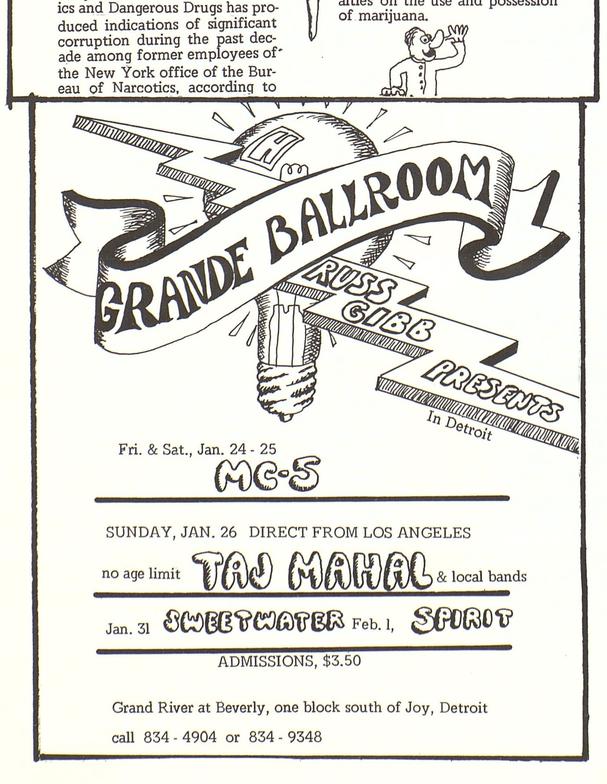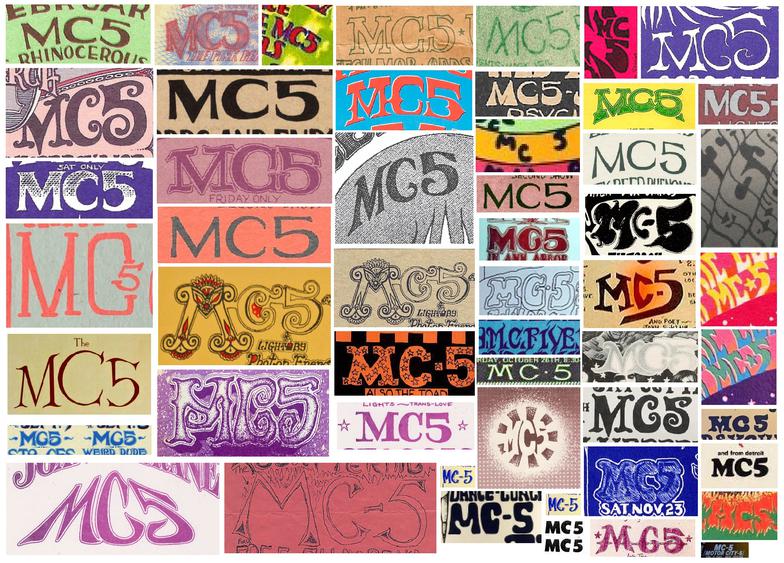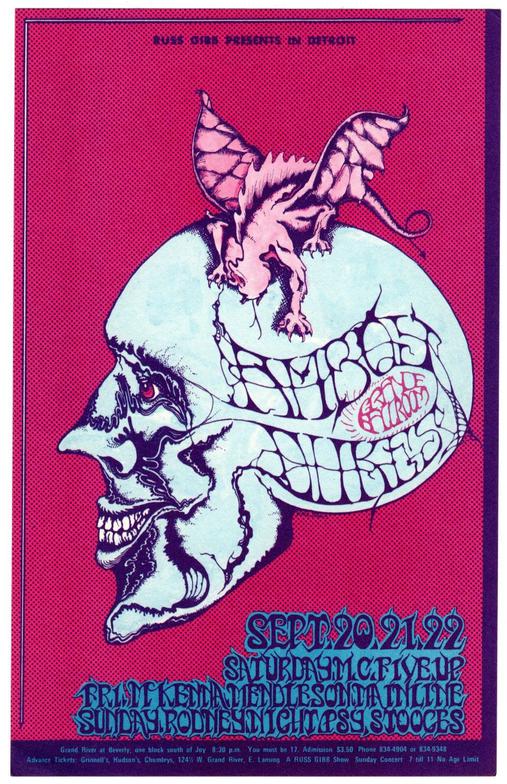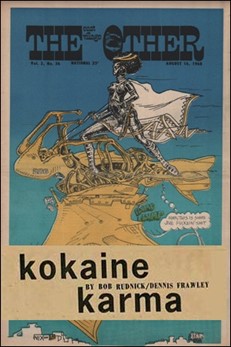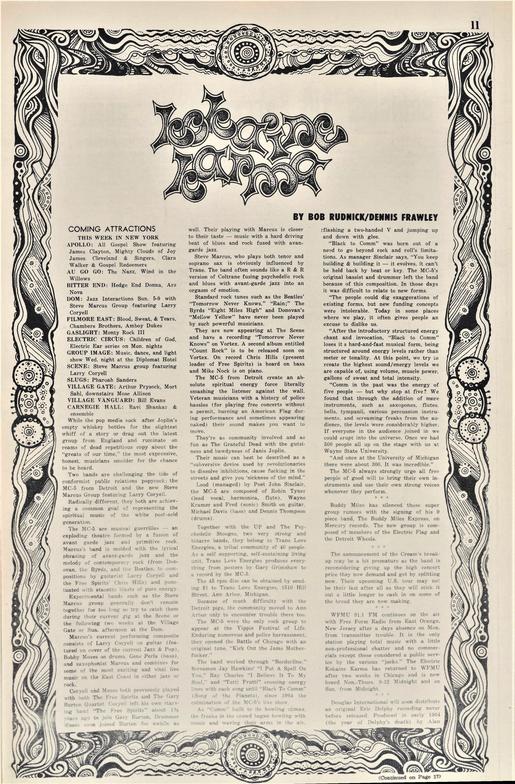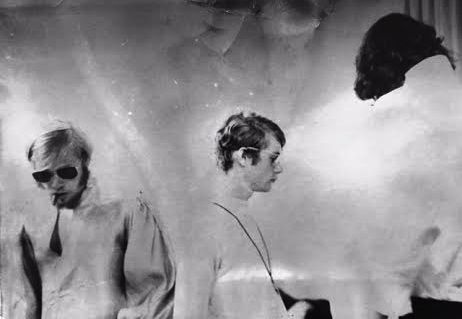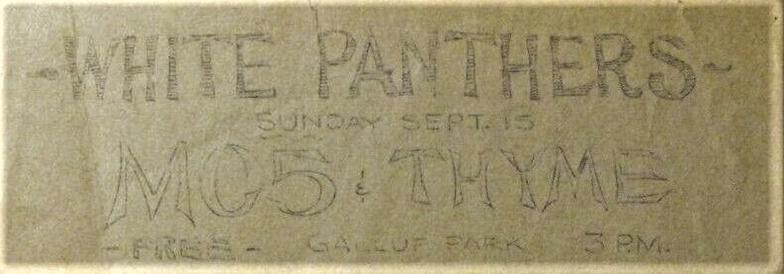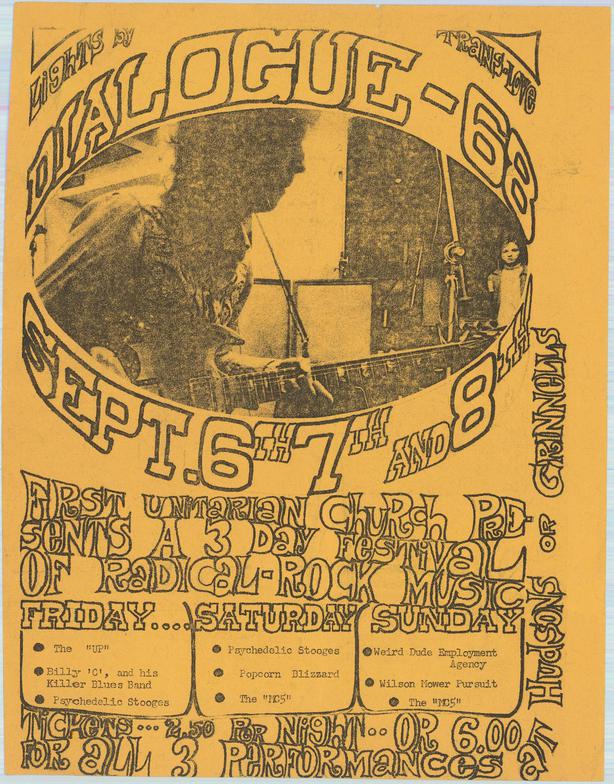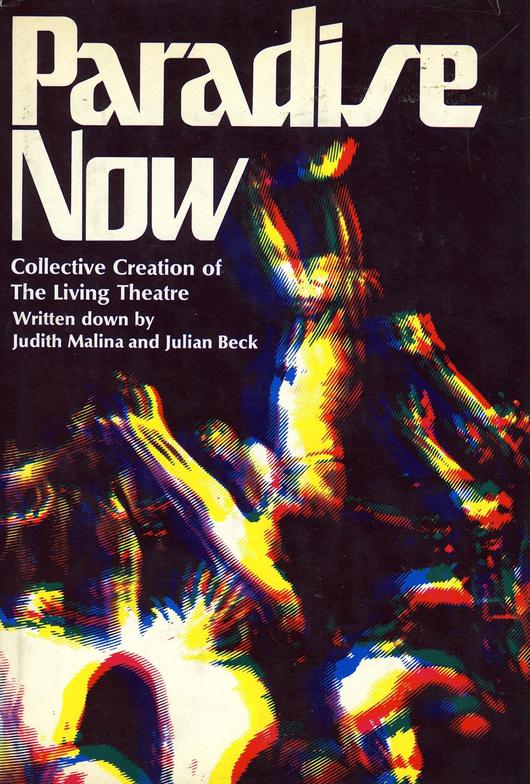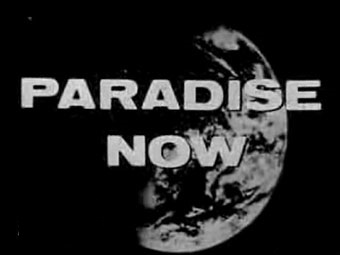Splatt Gallery
Double click here to add text.
Splatt Gallery's History of Michigan Music Posters
MC5 - Page Five
************************************************************
The following Monday night, September 23, 1968, John Sinclair took Danny Fields to the Union Ballroom in Ann Arbor, Michigan to see the Psychedelic Stooges for the first time. Fields was very impressed with Iggy, Iggy with Fields, not so much, when Fields introduced himself, Iggy told him to talk to band manager, Jimmy Silver. Poster by Robin Sommers.
It appears that the MC5 performed a free show on The Diag on the University of Michigan campus in Ann Arbor prior to their show that night, September 23, 1968, at the Union Ballroom, where Danny Fields would see the Stooges perform for the first time.
We believe we have solved the mystery of the location for these MC5 shows on September 30 – October 1, 1968. The database lists these as “unknown”. Some sources have suggested that “the great hall” was the Great Hall of the Detroit Institute of Arts, which didn’t make sense why the flyer would advertise “freek-rock from Detroit” for a show in Detroit. Suggestions for the location of “green lantern” ranged from a blacks-only casino in Ohio to a defunct dancehall converted into a roller rink in Indiana.
But we can pretty definitely say that these shows were in Milwaukee, Wisconsin.
There is obviously incorrect information on the flyer, such as “John Sinclair, lead singer”, and “playing on their 3rd national tour”. The three quotes are also probably fake, but the first one, attributed to John Kois, Kaleidoscope, was the key.
Kois was the founder and editor of Kaleidoscope, Milwaukee’s underground newspaper, and we found a restaurant on the campus of the University of Wisconsin – Milwaukee that was a hang-out for leftist radicals and art students, called the Green Lantern Eating Co-Op. The following post will show a photo and a poster for the place. The “great hall” can be reasonably be presumed to be a campus facility.
Photo of the Green Lantern Eating Co-Op in Milwaukee, Wisconsin, circa 1969 and a 1970 poster. In the photo, you can see posters on the door and window, some of which are very similar in style (same artist?) as the MC5 flyer for the October 1, 1968 show.
Another farmland party spot for Western Michigan kids, at least for one day, October 6, 1968, was a place called the Little Cheyenne Ranch outside Grand Rapids. A Festival of Life Autumn Equinox celebration was able to bring the MC5, Frost, and UP out to the hinterlands, so it may have been an individual connected with the bands or with Trans-Love that hosted the event, perhaps on their private property. The poster by an unknown artist included a detailed map on to get there.
Just before World Championship mania swept up Tiger Town, we last saw Elektra Records talent scout, Danny Fields in town, staying at the MC5 house, checking out the Grande Ballroom, and catching the Stooges at a gig in Ann Arbor. The following morning, at the MC5 breakfast table, Fields made the jaw-dropping offer to sign both groups, with The MC5 getting $20,000 and the Stooges five grand. The MC5 paid off equipment loans and treated themselves to new leather coats from Louis the Hatter.
The two bands played a celebration show, astrologically accurate for the date, October 8, 1968, called a “Ce-LIBRA-tion” by poster artist Robin Sommers, at The Fifth Dimension in Ann Arbor, Michigan. The show was a wild abandonment, literally destroying the stage and surroundings, putting the final stake into the life of The Fifth Dimension, beleaguered by dwindling audiences after a large expenditure adding air conditioning to the room, not even the Russ Gibb connection that had brought Grande Ballroom encore acts throughout the summer could save it.
A rival Hullabaloo franchise club had opened right down the street, but the market that could no longer sustain one club certainly could not sustain two, and they both ended up folding.
The Fifth Dimension in Ann Arbor was finished, they knocked a hole in the wall with a wrecking ball and bulldozed all of the stuff out, completing the destruction job that Rob Tyner had begun with his mic stand. It had lasted two years, opening the same weekend in October, 1966 as the Grande Ballroom, and had produced a nice body of poster work by artist Mickey Kress, who summarized the experience as “it was $80 a week and all I could watch”.
For the MC5, the band that built the Grande, plans were being made to record their first album, and it was decided that, contrary to first-album convention, it would be a live recording and it would be recorded at the Grande Ballroom.
Newspaper ad for the MC5 and the Stooges record-signing celebration show at the Fifth Dimension in Ann Arbor, Michigan, October 8, 1968. Whereas Robin Sommer’s poster made a play of the word “celebration”, writing it as Ce-LIBRA-tion, evoking a “liberation”, the newspaper’s mis-print accidently evokes a female body part. They also misspelled the Elektra record company.
The 107th weekend at the Grande Ballroom, October 18-20, 1968, featured the first poster by artist Bonnie Green, one of the persons who took up Carl Ludgren’s call for new poster artists on Russ Gibb’s radio show. The poster lists the three dates, 18-20, but it appears that were only two shows by the Kensington Market, supported by Pacific Gas & Electric both nights, with MC5 on the first night, October 18, 1968, and Renaissance Faire on the second night.
You can also add Kensington Market from Toronto, Canada and Pacific Gas & Electric from Los Angeles, California to the list of bands who made their Michigan debut at the Grande Ballroom.
Newspaper ad for the Kensington Market shows at the Grande Ballroom, October 18-20, 1968, plus the upcoming weekend.
The lack of posters or ads was not for a lack of shows by the MC5 in October 1968. The Database has them at the Peek-a-Boo Club in Westland, Michigan on October 4th, at the Cellar in Arlington Heights, Illinois on October 5th, and an unconfirmed show at the Grande Ballroom on October 10th.
The Gateway also has the Peek-a-Boo Club, the Cellar, plus the Benton Harbor Hullabaloo in Benton Harbor, Michigan on October 9th, at an un-named club in Amherstberg, Ontario, Canada on October 11th (or possibly opening for Alice Cooper in Philadelphia on that night) (?), at Saginaw Auditorium in Saginaw Michigan on October 12th, a Black Panther Benefit at Wayne State University in Detroit on the 18th (same date as the Kensington Market show at the Grande Ballroom, at an unknown venue in Sebewaing, Michigan on October 25th, and at an un-named venue in Findlay, Ohio on the 26th (conflicting with the Crazy Horse).
Poster by James Render for the MC5 at the Silverbell Hideout on October 19, 1968.
On Sunday night, October 27, 1968, the Grande Ballroom held another benefit for State Senator Roger Craig, the pro-marijuana legalization legislator, with the Rationals and the MC5. playing their last show before the Elektra recording date in three more days. Here is a recording from Sunday night, October 27, 1968 of a free-form jam they called “I’m Mad like Eldrige Cleaver”.
MC5 – I’m Mad Like Eldrige Cleaver (live) (1968)
https://www.youtube.com/watch?v=NqvJto-X5yk
A big blow-out at the Crazy House in Portage, Michigan on this poster by an unknown artist with a two-day Kalamazoo Pop Festival, October 26-27, 1968. The MC5 performed on the first day, October 26, 1968.
This appears to be the final appearance by the Ann Arbor band The Thyme, ending a four-year run that had started as The Hitch Hikers from Kalamazoo. Bass player, Al Wilmot joined SRC, just as the first SRC album was being released.
And finally, the nights had arrived, Devils Night and Halloween, October 30-31, 1968, just happening to coincide with the Zenta New Year in the Trans-Love’s newly adopted religion. Bruce Botnick and Wally Heider from Elektra Records were parked outside the Grande Ballroom in a recording truck, admission was free to friends and fans, and The MC5 were taking the show seriously enough that “instead of smoking 15 joints before the show, we probably only smoked 10”. The Psychedelic Stooges opened both nights.
Using Leni Sinclair’s photo of the band that had been published in the March 1968 issue of the SUN newspaper, Matthew Radofsky, aka Matt Rock, made this historic poster.
On November 1, 1968, John Sinclair announced the formation of The White Panther Party in emulation and solidarity with the Black Panthers. Gary Grimshaw created the new logo. The White Panther logo was printed on buttons and distributed freely to the crowds at MC5 shows.
Spotted this poster for the MC5 and Gray Frog at St Lawrence High School in Utica, Michigan on November 1, 1968. The photo is from the school newspaper on the day of the show. The poster has got to be a rare one!
Bruce Botnick took the tapes he’d made of The MC5 at the Grande Ballroom back to Los Angeles to begin mixing the album, and the band hardly took a breath before jumping right back into their busy show schedule, they played the following night at the Lawrence Catholic Church in Utica, Michigan, and the following night after that, November 2, 1968, at the Union Ballroom in East Lansing.
Initial version of the ad for the MC5 at the Union Ballroom, November 2, 1968 in The Paper, East Lansing, Michigan’s underground newspaper, from a few weeks before the show.
This looks like another James Render poster for the Silverbell Hideout, in Clarkston, Michigan, November 2-3, 1968, although it doesn’t look like it has his name running along the side as was typical for his “Spectrum Design” posters. John Orlich, who was Render’s replacement as the drummer for the band The Stuart Avery Assemblage has confirmed that this is a Render poster, as has Render himself, making it his 31st known poster to date.
Bob Seger System with the Shags and Asian Flu on Saturday night, November 2nd, and the MC5, Psychedelic Stooges and Dharma on Sunday, November 3, 1968.
Poster by an unknown artist for a November 9, 1968 Saturday night at the Silverbell Hideout in Clarkston, Michigan, by an unknown artist, printed the night before the Sunday show with the MC5 on November 3, 1968.
The Gateway has this as another MC5 show on November 9th, but we think that is a mis-reading of the poster.
Poster by Carl Lundgren for November 15-16, 1968, for a Mike Quatro production of the MC5 on November 15, 1968 and the Unrelated Segments the following night at a place called Grass in Muskegon.
Poster by Gary Grimshaw for Russ Gibb’s off-shoot Grande Ballroom in Cleveland, Ohio. Jeff Beck performed on November 22-23, 1968, with the MC5 opening on November 23, 1968, and Blood Sweat & Tears performed on November 30th with the Stooges opening. There do not seem to be any shows afterwards at this short-lived venue.
We saw a poster for the Weslow Hall in Riverview, Michigan, earlier with a similar generic rocking teenage combo illustration by this unknown artist for a Bob Seger concert. For the show by The MC5 on November 24, 1968, the flourishes of Uncle Emil included the claim of the Hardest Working Band in Show Business, pronounced the band was John Sinclair’s MC-5, and that they would be performing “high” lites from their up-coming album on Elektra Records.
The 113th weekend at the Grande Ballroom, November 27, 1968 through December 1st, featured Donnie Dope’s 23rd poster for the venue, which also included special Wednesday, Thursday, and Sunday shows.
Newspaper version Donnie Dope’s poster for the Grande Ballroom, November 27, 1968 through December 1st. Being easier to read than the poster, we can determine the complicated schedule was:
Wednesday, November 27, 1968 – MC5, Frost and Stooges
Thursday, November 28, 1968 – MC5, Frost and Stooges
Friday, November 29 – Blood, Sweat &Tears and Stuart Avery Assemblage
Saturday, November 30 – Rationals and Dharma
Sunday, December 1 – Grateful Dead and Popcorn Blizzard
We recounted earlier that one of the very first gigs for The MC5 was at Plymouth High School in Plymouth, Michigan in 1965. Now, over three years later, they returned to Plymouth, to a club called Purple Haze on this poster by an unknown artist on November 29, 1968.
Poster by James Render Spectrum Design, for the MC5, Frijid Pink, and Black Sun at the Silverbell Hideout in Auburn Hills, Michigan, November 30, 1968.
Elektra Records decided to book the MC5 for some East Coast shows in order to generate some excitement for their upcoming album. Unfortunately, John Sinclair, in full revolutionary fervor, having just launched his White Panther Party, on this trip, struck up an association with an extreme radical group from the Lower East Side of New York City that had started as a Dada art-inspired group called Black Mask, but had evolved, even further underground, into a group that called itself Up Against the Wall, Motherfucker.
The first gig that Elektra Records booked for the MC5 on their East Coast promo tour for the upcoming album release was at The Boston Tea Party, opening for The Velvet Underground for three nights, December 12-14, 1968. The poster was made by Steve Nelson, one of the club’s original managers who we chronicled in our earlier posts about The Boston Tea Party.
At the end of the MC5’s final night, John Sinclair allowed his new-found friends, the Motherfuckers, to take the microphone. They began riling up the crowd, telling them that the Tea Party was ripping them off and exhorting them to destroy the theater. They were hustled off the stage and Lou Reed began the Velvet’s set by disavowing the brief spectacle, calling it “stupid” and saying they loved the Tea Party, to which the crowd roared in approval.
Even worse than making their name equal to mud with the Boston audience, the MC5 had really pissed off promoter Don Law, who not only banned them from the Tea Party, but who also had a major influence with the network of promoters nationwide and was able to put them on a wide black-list. As was typical of The Five, they got out of town, blissfully unaware of the carnage left in their wake, and headed to NYC.
The Motherfuckers were constantly harassing Bill Graham, insisting that his Fillmore East venue in New York City should be “free to the people”, and eventually got him to concede to allowing them to use the venue on Wednesday nights for their gatherings, which generally became a weekly degenerate open market for drug dealing and gang squabbles.
The MC5 spent their days in New York City visiting the Elektra Records office to check on the progress of album, and doing some experimental recordings at The Living Theatre and the Brooklyn Academy of Music. At night, they partied with their new friends, the Motherfuckers, who suggested that the band play at their next Wednesday free-night, December 18, 1968, at The Fillmore East, prompting this quickie poster by an unknown artist.
They showed up late for the gig, due more to their pre-show ritual of getting wasted than out of any disrespect, but the surly crowd took it that way and the scene was tense as rival gangs rumbled and street people used the stage as a crash pad, barring knives when they thought the band was becoming intrusive to their resting space.
Following this night, Bill Graham had his fill of his disgust with the abuse of the Wednesday free-nights, and was not pleased that the MC5, whom he had booked for the venue the following week for their big New York debut had upstaged that event with this impromptu appearance. He announced that the free-nights were finished, enraging the Motherfuckers. Again, the Five, unaware of the turmoil they’d caused, got on a plane back to Detroit to open for Arthur Brown at the Olympia Stadium.
In their Kokaine Karma column in the East Village Other, Bob Rudnick and Dennis Frawley reviewed the MC5’s East Coast trip, writing glowingly about the shows, and announcing that they would be returning on the 26th for the Elecktra-sponsored show at the Fillmore East. Gary Grimshaw provided the long strip graphic that accompanied the article.
Gary Grimshaw designed logo for the Kokaine Karma column in the East Village Other. The column’s authors, Bob Rudnick and Dennis Frawley, had been given a radio show on the fledgling free-form station WFMU on the basis of their column and with the same name, Kokaine Karma. They strained their relationship with the radio station by playing the uncensored version of “Kick Out The Jams”, causing the station to briefly lose the use of their broadcasting antenna, and by the spring of 1969, the pair departed WFMU and moved to Detroit, joining the White Panther Party. Through his connections with WABX station manager John Detz, John Sinclair was able to get them 2am to 7am overnight slot for the Kokaine Karma show on WABX.
Carl Lundgren made the poster for the December 23, 1968 appearance of The Crazy World of Arthur Brown at the Olympia Stadium in Detroit.
The MC5 are shown on the bottom of the ring of fire letters, as we know, they came back to Detroit in the middle of their East Coast tour to make this show, in front of an audience of 17,000.
The newspaper ad for The Crazy World of Arthur Brown at the Olympia Stadium in Detroit, December 23, 1968, showing the publicity photo that Carl Lundgren used in his poster for the event. Promoter Mike Quatro could not have known that Brown would extend his Detroit visit to fill-in for the no-show New York Rock & Ensemble the following night at the Grande Ballroom, but his claim of “the only Detroit appearance” forgets that Brown had already performed five shows in Detroit earlier in the summer.
The Crazy World of Arthur Brown – Fire (1968)
https://www.youtube.com/watch?v=en1uwIzI3SE
A second newspaper ad for Arthur Brown with MC5 at Olympia Stadium, December 23, 1968.
The MC5 were given the “Yellow Submarine” treatment on the cover of the 1968 Gala Christmas Issue of The Fifth Estate newspaper, as drawn by Matthew, whom we guess is Matthew Radofsky, aka Matt Rock. The Beatles movie had been released that summer.
The MC5 flew back to NYC for their originally-planned debut at The Fillmore East, December 26, 1968, still not realizing the ramifications of their pre-emptive stunt with the Motherfuckers a week earlier. After that night, a miffed Bill Graham had put an end to the Wednesday night appeasements to the radical group and the Motherfuckers were ready for war. They expected the MC5 would be their allies in burning the place down and became infuriated when Rob Tyner insisted the night was for music over politics, and the band roared through their set and started packing up to leave.
In a decision he came to regret, Elektra Record’s Danny Fields had hired a stretch limousine to pick up the band and when the luxury automobile showed up, the Motherfuckers erupted in rage, calling the band sell-outs and pretentious rock stars. They wrestled with the crew packing the equipment, stealing what they could, knives and chains were drawn, and in the fracas Bill Graham suffered a broken nose from a blow by a chain that he swore was wielded by MC5 lead singer, Rob Tyner(which by all accounts is untrue).
Guitarist Wayne Kramer was nearly stabbed when he tried to reason with the crowd and he was thrown into the back of the limo as it sped away under a hail of rocks and bottles, becoming another chapter in Kramer’s running account of “Riots I have known and loved”.
It was an auspicious end to the first year of Bill Graham’s Fillmore East that had opened in March of 1968, but as we know, the Fillmore East became not only one of the most famous venues in the country, but because of its excellent acoustics, also became the premier location for recording live albums for dozens of classics from the Allman Brothers to Frank Zappa (with John and Yoko).
The poster shown above was used regularly with the specific band and date information printed on the back side. It was designed by the legendary David Edward Byrd, who got his start in New York as the main poster artist for the Fillmore East before moving to Los Angeles, California where his work has gone far beyond concert posters, including Warner Bros, Hanna-Barbera, and creating the look and master style guide for the Harry Potter franchise.
Meanwhile, back on the East Coast, the MC5 retreated from NYC to the relatively bucolic Stratford, Connecticut for two shows on this poster by an unknown artist at The Ballroom, December 27-28, 1968. The opening band, Orient Express was a trio whose members were from France, Belgium, and Iran, whose instrumentation included the oud, sitar, mini-tar, melodica, dumbelek and darabukka. The group moved to New York’s East Village, producing one album in 1969 that stands as a worthy early experiment in world fusion music.
The MC5 were scheduled to end their East Coast tour with a New Year’s Eve show on this poster by an unknown artist at the Broadway Central Hotel in Greenwich Village, NYC, but Bill Graham had already put the word out not to hire the MC5, so this appearance was cancelled and the band went home to Detroit.
While The MC5 were on the East Coast, Issue #25 of Rolling Stone magazine hit the streets with Rob Tyner on the cover, which would have been perfect timing for generating interest in the band as they planned to win over fans outside of Detroit. But as we’ve seen, the end result of the promo tour was being banned by two of the largest promoters in the country, Don Law and Bill Graham (Graham extended his animus to all bands from Detroit), alienating fans of the Boston Tea Party, and being labeled as sell-outs by leftist radicals. If you thought it couldn’t get any worse, well, it could.
1969
For its first issue of the new year, and its 25th issue in publication, Rolling Stone magazine featured MC5 lead singer Rob Tyner on the cover, dated January 4, 1969. It was the magazine’s first cover appearance of a Michigan artist, and it would take well over two years until the next one.
Rolling Stone magazine came up with an interesting, if not flat out horrible, logo for the feature story on the MC5 in the January 4, 1969 issue.
On January 17, 1969, the MC5 appeared at the Village Pub in Birmingham, Michigan. This show was filmed by Leni Sinclair and used in a montage promo film called “Kick Out the Jams” that would be used as a stage intro in later tours. Poster by James Render.
The MC5 – Come Together (1968)
https://www.youtube.com/watch?v=2IBcey6i_X4
The 121st weekend at the Grande Ballroom, January 24-26, 1969, featured another poster by Robin Sommers with a classic Leni Sinclair photo of MC and Zenta high priest, J.C. Crawford. The MC5 headlined two nights, January 24-25, 1969, with support by the March Brothers both nights, and with Train and Piers for one night each.
The Sunday show featured the first Michigan appearance by Taj Mahal and the last known appearance of the band named Asian Flu (seen earlier opening for Bob Seger at the Silverbell Hideout in November, 1968.
The MC5 – Rocket Reducer No. 62 (Rama Lama Fa Fa Fa) (1968)
https://www.youtube.com/watch?v=Ll5kKCzHii0
A newspaper ad for the January 24 through February 1, 1969 run of shows at the Grande Ballroom featured a cool, new “lightning bulb” logo, by Ann Arbor Argus cartoonist Dave Baker, that would get repeat usage throughout the year.
It lists the January 24-26, 1969 shows by MC5 and Taj Mahal along with a show by Sweetwater at the Grande Ballroom on January 31, 1969, and a show the next day by Spirit and Sweetwater.
Poster History of the MC5 - continues - HERE
The MC5 essentially doubled their amount of live appearances in 1968, from around (60) the year before to over (120). Almost all of the shows were still in Michigan although they ventured to Chicago, Cleveland, Ohio, and ended the year with six shows on the East Coast, in New York, Boston, and Stratford, Connecticut.
The 103rd weekend at The Grande Ballroom, September 20-22, 1968 featured Donnie Dope’s 17th poster for the venue. The Amboy Dukes headlined three nights, supported by the McKenna Mendleson Mainlineon the first night, MC5 and UP on Saturday, September 21, 1968, and Rodney Knight & the Soul Sextet and the Psychedelic Stooges on the final night.
It was the first time that the MC5 played the Grande in three months, since the Blue Cheer show in June, and Danny Fields from Elektra Records was in the audience to see The Five for the first time.
After the Dialogue ’68 shows, John Sinclair traveled to New York to promote the MC5’s single “Borderline” and to meet Bob Rudnick and Dennis Frawley, whose “Kokaine Karma” column in The East Village Other newspaper had led them to start a radio show of the same name on the legendary WFMU radio station. Rudnick and Frawley were already enthusiastic supporters of The MC5, reading about their exploits in The Fifth Estate, which was a charter paper along with The Other in the Underground Press Syndicate, and being the only band that dared to show up and perform at the Festival of Life Festival in Chicago had raised their profile.
Rudnick and Frawley, on WFUM, were the only ones outside Detroit giving airplay to “Borderline” and Sinclair supplied them with tapes of MC5 live performances, which later landed the pair in hot water with the radio station. During the visit, they introduced Sinclair to Danny Fields, the resident house hippie at Elektra Records who had raised his own profile considerably when he brought The Doors to the label. Fields agreed to make the trip to Detroit to see The MC5 for himself.
The September 13, 1968 edition of Kokaine Karma in the East Village Other newspaper in New York City, in which Bob Rudnick and Dennis Frawley write about the MC5 for the first time. They also mention the formation of the Buddy Miles Express, “comprised of members of the Electric Flag and the Detroit Wheels”, (actually only guitarist Jim McCarty).
Photo of JC Crawford with Dennis Gainer, senior class president at Bishop Gallagher High School in Harper Woods, Michigan on a Friday night, “less than a month” after the MC5 had been the only band to show up at the Democratic National Convention in Chicago, likely September 20, 1968. Frut opened the show and the MC5 practiced some restraint by using “KICK OUT THE JAMS, MOTHER SUPERIOR!”.
The complete story can be found here:
https://beltmag.com/kick-out-the-jams-catholic-school/
Top portion of a White Panthers flyer with the announcement of a Sunday free concert at Gallup Park in Ann Arbor, Michigan on September 15, 1968 with MC5 and Thyme. We need to find out how this was a White Panthers item about six weeks before John Sinclair announced the formation on November 1, 1968.
A flyer by an unknown artist for the Dialogue ’68 Festival at the First Unitarian Church in Detroit, September 6-8, 1968.
An ad for the Hullabaloo club in Benton Harbor, Michigan with UP (“proteges of MC5”) appearing on October 26, 1968.
While in New York on December17, 1968, and/or the 19th to the 22nd, MC5 participated in a recording session of musical performance to "Paradise Now" (The Living Theatre) at the BAM (Brooklyn academy of Music). A free-form group freak-out, fairly unwatchable, but can be viewed at the link below. You’ll first scroll through a short story by Keith Richards of his encounter with Donyale Luna, the world’s first supermodel, inspirer of Salvadore Dali, and Detroit’s Cass Tech graduate.
https://arthurmag.com/tag/paradise-now/


